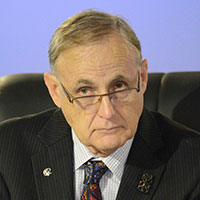

Over the last decade, we have learned that a serious banking failure with risky balance sheets can feed into a major international financial crisis. That, in turn, is big enough to cause an economic crisis as we saw with the "Great Recession." The down-turn in growth, trade and productivity that followed also opened up the possibility of a new contagion today.
The global financial crisis, which I confronted as Governor of the Reserve Bank of New Zealand at that time, masked some very important developments that in the ensuing years have fostered both recovery and new risks. One of the biggest has been continued strong growth in China, which helped keep world production growth buoyant thanks to huge Chinese fiscal stimulus.
During this period, China increased its domestic value add and pushed up the value chain in line with its "Made in China" policy. Notably, China has boosted its share of trade in fast-growing markets, harnessing facilitating measures driven by practical engagement with the Philippines and peer Asia-Pacific Economic Cooperation member economies, and invested heavily under the Belt and Road initiative.
All the while, we have seen a socio-economic metamorphosis globally like no other in history – from the on-going energy revolution to big surges in middle income growth and consumption in emerging APEC economies such as China, the Philippines, and others in Southeast Asia and Latin America to demographic shocks due to aging and lower birth rates to accelerating technological change.
The implications of these phenomena for traditional industries, jobs and communities have stoked fears about globalization’s costs that lie behind current trade frictions. It is a situation that raised a red flag during the IMF-World Bank Annual Meetings in Bali and provides impetus for APEC finance ministers who are meeting next week in Port Moresby, Papua New Guinea, to act.
Ironically, much of the imbalances at the time of the global financial crisis have since narrowed, though not those in the United States where the Trump Administration has followed a policy to reduce imports from trade deficit economies. It is an approach that has disrupted US trade negotiations with the EU, North American neighbors, Korea, Japan, and, especially, China.
The resulting breakdown in bilateral trade talks and escalation of tariffs and other protectionist barriers by the US and China is beginning to hurt both economies. More broadly, these trade tensions could reduce international growth by around 0.5% by 2020, the IMF reports. It is pressures on third countries that are hardest to forecast but which should worry us most.
The fallout comes from increased production costs which will impact shareholders, workers and consumers, sometimes in round-about ways. Producers are looking to reconfigure increasingly complex supply chains to avoid tariff penalties. Purchasing managers are ramping up inventory just in case. Factory owners are considering relocation for cheaper options. Financial investors are reassessing country risk.
A considerable amount of affected Chinese exports to the US have much third country content or are produced by foreign investors. In the APEC region, industrial production has relocated very fast when costs change. Now investors in Northeast Asia and supply chain operators in Southeast Asia are considering relocation again.
So far, most of the economies in the region look to be in good shape, but their prosperous future is not guaranteed as traditional trade growth drivers are threatened. It may be that some future economic risks are not yet fully priced into markets. Already there have been significant swings in exchange rates as the US reserve currency strengthens and some third countries are considering erecting new tariff structures themselves.
APEC finance ministers are convening in Papua New Guinea to address these issues, including growth prospects and how to make tax policies, financing and economies more effective and inclusive. But now, as they prepare their advice for the region’s leaders to meet there in November, like President Duterte, there is another issue on the agenda – new economic and financial risks.
Since the global financial crisis, financial sector debt has decreased appropriately, but cheap credit has brought mounting debt in the private sector and state-owned enterprises in emerging markets such as the Philippines. Deteriorating local currencies and tightening international monetary policy could make it difficult to service some of this debt. Tariff increases causing domestic inflation would worsen policy options.
Ten years ago, we saw how badly managed financial risk could hurt the world’s economies. A decade later, we do not want to see how badly managed economic risk could trigger another financial crisis. – Rappler.com
Dr Alan Bollard is the Executive Director of the Asia-Pacific Economic Cooperation (APEC) Secretariat in Singapore and former governor of the Reserve Bank of New Zealand from 2002-2012.